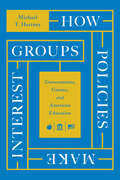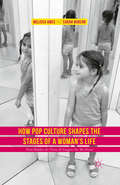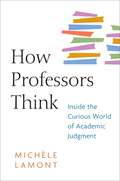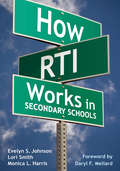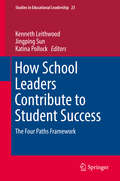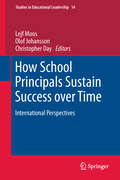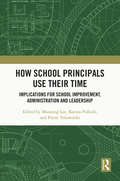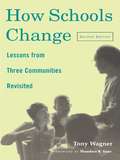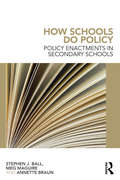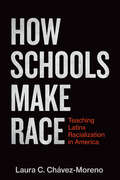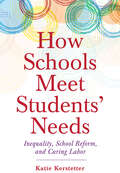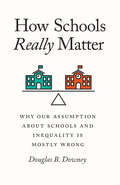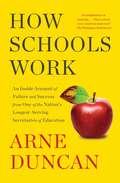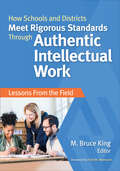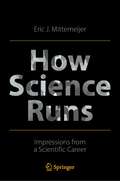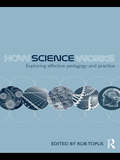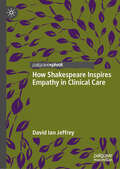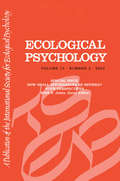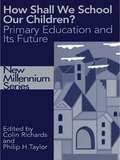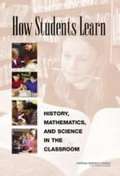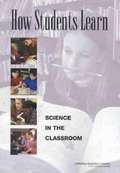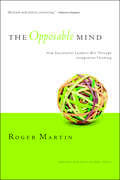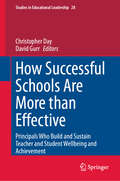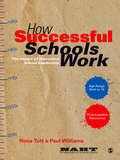- Table View
- List View
How Policies Make Interest Groups: Governments, Unions, and American Education
by Michael T. HartneyA critical, revelatory examination of teachers unions' rise and influence in American politics. As most American labor organizations struggle for survival and relevance in the twenty-first century, teachers unions appear to be an exception. Despite being all but nonexistent until the 1960s, these unions are maintaining members, assets—and political influence. As the COVID-19 epidemic has illustrated, today’s teachers unions are something greater than mere labor organizations: they are primary influencers of American education policy. How Policies Make Interest Groups examines the rise of these unions to their current place of influence in American politics. Michael Hartney details how state and local governments adopted a new system of labor relations that subsidized—and in turn, strengthened—the power of teachers unions as interest groups in American politics. In doing so, governments created a force in American politics: an entrenched, subsidized machine for membership recruitment, political fundraising, and electoral mobilization efforts that have informed elections and policymaking ever since. Backed by original quantitative research from across the American educational landscape, Hartney shows how American education policymaking and labor relations have combined to create some of the very voter blocs to which it currently answers. How Policies Make Interest Groups is trenchant, essential reading for anyone seeking to understand why some voices in American politics mean more than others.
How Pop Culture Shapes the Stages of a Woman's Life: From Toddlers-in-Tiaras to Cougars-on-the-Prowl
by Melissa Ames Sarah BurconContemporary popular culture has created a slew of stereotypical roles for girls and women to (willingly or not) play throughout their lives: The Princess, the Nymphette, the Diva, the Single Girl, the Bridezilla, the Tiger Mother, the M.I.L.F, the Cougar, and more. In this book Ames and Burcon investigate the role of cultural texts in gender socialization at specific pre-scripted stages of a woman's life (from girls to the "golden girls") and how that instruction compounds over time. By studying various texts (toys, magazines, blogs, tweets, television shows, Hollywood films, novels, and self-help books) they argue that popular culture exists as a type of funhouse mirror constantly distorting the real world conditions that exist for women, magnifying the gendered expectations they face. Despite the many problematic, conflicting messages women receive throughout their lives, this book also showcases the ways such messages are resisted, allowing women to move past the blurry reality they broadcast and toward, hopefully, gender equality.
How Professors Think
by Michèle LamontEveryone in academia stresses quality. But what exactly is it, and how do professors identify it? Michèle Lamont observed deliberations for fellowships and research grants, and interviewed panel members at length. In How Professors Think, she reveals what she discovered about this secretive, powerful, peculiar world. Lamont aims to illuminate the confidential process of evaluation and to push the gatekeepers to both better understand and perform their role.
How RTI Works in Secondary Schools
by Lori A. Smith Evelyn S. Johnson Monica L. HarrisPractical solutions for implementing RTI and improving student outcomes in Grades 6–12! This comprehensive book provides the specific guidance secondary administrators need to successfully implement Response to Intervention (RTI) and help their struggling adolescent learners. Using the latest research, the authors identify the current best practices for key components of RTI and demonstrate how teams can work together to implement an assessment- and data-driven decision-making process. The book provides: Guidance on building leadership capacity for RTI implementation Case studies illustrating middle and high school RTI models Instructional strategies for tiers one, two, and three Forms, checklists, and Web and print resources
How School Leaders Contribute to Student Success
by Kenneth Leithwood Jingping Sun Katina PollockWhile considerable evidence indicates that school leaders are able to make important contributions to the success of their students, much less is known about how such contributions are made. This book provides a comprehensive account of research aimed at filling this gap in our knowledge, along with guidelines about how school leaders might use this knowledge for their own school improvement work. Leadership practices known to be effective for improving student success are outlined in the first section of the book while the remaining sections identify four "paths" along which the influence of those practices "flow" to exercise an influence on student success. Each of the Rational, Emotional, Organizational and Family paths are populated by conditions or variables known to have relatively direct effects on student success and also open to influence by effective leadership practices. While the Four Path framework narrows the attention of school leaders to a still-considerable number conditions known to contribute to student success, it leaves school leaders the autonomy to select, for improvement efforts, the sub-set of conditions that make the most sense in their own local circumstances. The approach to leadership described in this book provides evidence-based guidance on what to lead and flexibility on how to lead for purposes of improving student learning.
How School Principals Sustain Success over Time
by Lejf Moos Christopher Day Olof JohanssonThis work represents a publishing event in education research. Genuinely groundbreaking, it is the result of longitudinal research from five nations over five years. The authors set themselves an unprecedented task: to analyze how it is that successful school principals sustain positive outcomes over a significant period of time. To find out, they initiated the International Successful School Principal Project (ISSPP) assembling 30 multinational case histories and numerous comparative analyses. In doing so, they recorded fresh perspectives on the influence school principals can have on their schools, the quality of teaching in their classrooms, and student outcomes. Revisiting the subject schools in 2007, they found many principals still in place, having steered their organizations through various minefields of political, governance and educational reform. As the most penetrating longitudinal investigation of the subject, this research has unearthed fascinating new insights into school leadership that add real substance to the sum of our knowledge. It incorporates data from educational systems in Australia, Denmark, Norway, Sweden, England and the USA. One key finding is that while all principals delegate a range of leadership tasks, successful ones distribute responsibility on a case-by-case basis founded on personal assessments of their staff as well as on organizational and policy contexts. The research also demonstrates that successful principals maintain close communication with their staff and the wider school environment, and that they are adaptive, maximizing the opportunities presented by new political contexts and expectations, yet without losing sight of their school's core moral and ethical principles. The volume's international thematic analysis has allowed comparative conclusions to be drawn on what the principals do to sustain and foster pedagogical and institutional success.
How School Principals Use Their Time: Implications for School Improvement, Administration and Leadership
by Katina Pollock Moosung Lee Pierre TulowitzkiPresenting international evidence, from school systems across the globe, this book documents patterns, causes, and effects of school principals’ time use, building a case for the implications for school improvement, administration, and leadership. This edited volume offers an unparalleled set of chapters that delve into conceptual and methodological issues in researching principals’ time use. Chapters consist of empirical studies that advance fresh perspectives and build empirical ground on how principals use time across different school systems in Africa, Asia, Europe, Middle East, Oceania, and North America. This unique book, is a useful resource for researchers and educators, capturing the geographically diverse contexts of principal time use. This work makes a significant contribution to the field of school improvement, administration, and leadership with both theoretical depth and empirical grounding.
How Schools Change: Lessons from Three Communities Revisited
by Tony WagnerThe first edition of How Schools Change chronicled the efforts of three very different high schools to improve teaching and learning in the early 1990's. Now, in a new second edition, Wagner concisely summarizes the decade-long history of education reform efforts and revisits the three communities at the beginning of a new century.
How Schools Do Policy: Policy Enactments in Secondary Schools
by Meg Maguire Annette Braun Stephen J BallOver the last 20 years, international attempts to raise educational standards and improve opportunities for all children have accelerated and proliferated. This has generated a state of constant change and an unrelenting flood of initiatives, changes and reforms that need to beimplemented by schools. In response to this, a great deal of attentio
How Schools Make Race: Teaching Latinx Racialization in America (Race and Education)
by Laura C. Chávez-MorenoAn investigation into how schooling can enhance and hinder critical-racial consciousness through the making of the Latinx racialized group
How Schools Meet Students' Needs: Inequality, School Reform, and Caring Labor (Critical Issues in American Education)
by Katie KerstetterMeeting students’ basic needs – including ensuring they have access to nutritious meals and a sense of belonging and connection to school – can positively influence students’ academic performance. Recognizing this connection, schools provide resources in the form of school meals programs, school nurses, and school guidance counselors. However, these resources are not always available to students and are not always prioritized in school reform policies, which tend to focus more narrowly on academic learning. This book is about the balancing act that schools and their teachers undertake to respond to the social, emotional, and material needs of their students in the context of standardized testing and accountability policies. Drawing on conversations with teachers and classroom observations in two elementary schools, How Schools Meet Students’ Needs explores the factors that both enable and constrain teachers in their efforts to meet students’ needs and the consequences of how schools organize this work on teachers’ labor and students’ learning.
How Schools Really Matter: Why Our Assumption about Schools and Inequality Is Mostly Wrong
by Douglas B. DowneyMost of us assume that public schools in America are unequal—that the quality of the education varies with the location of the school and that as a result, children learn more in the schools that serve mostly rich, white kids than in the schools serving mostly poor, black kids. But it turns out that this common assumption is misplaced. As Douglas B. Downey shows in How Schools Really Matter, achievement gaps have very little to do with what goes on in our schools. Not only do schools not exacerbate inequality in skills, they actually help to level the playing field. The real sources of achievement gaps are elsewhere. A close look at the testing data in seasonal patterns bears this out. It turns out that achievement gaps in reading skills between high- and low-income children are nearly entirely formed prior to kindergarten, and schools do more to reduce them than increase them. And when gaps do increase, they tend to do so during summers, not during school periods. So why do both liberal and conservative politicians strongly advocate for school reform, arguing that the poor quality of schools serving disadvantaged children is an important contributor to inequality? It’s because discussing the broader social and economic reforms necessary for really reducing inequality has become too challenging and polarizing—it’s just easier to talk about fixing schools. Of course, there are differences that schools can make, and Downey outlines the kinds of reforms that make sense given what we know about inequality outside of schools, including more school exposure, increased standardization, and better and fairer school and teacher measurements. ?How Schools Really Matter offers a firm rebuke to those who find nothing but fault in our schools, which are doing a much better than job than we give them credit for. It should also be a call to arms for educators and policymakers: the bottom line is that if we are serious about reducing inequality, we are going to have to fight some battles that are bigger than school reform—battles against the social inequality that is reflected within, rather than generated by—our public school system.
How Schools Work: An Inside Account of Failure and Success from One of the Nation's Longest-Serving Secretaries of Education
by Arne DuncanFrom the Secretary of Education under President Obama, an exposé of the status quo that helps maintain a broken system at the expense of our kids’ education.“Education runs on lies. That’s probably not what you’d expect from a former Secretary of Education, but it’s the truth.” So opens Arne Duncan’s How Schools Work, although the title could just as easily be How American Schools Work for Some, Not for Others, and Only Now and Then for Kids. Drawing on nearly three decades in education—from his mother’s after-school program on Chicago’s South Side to his tenure as Secretary of Education in DC—How Schools Work follows Arne (as he insists you call him) as he takes on challenges at every turn: gangbangers in Chicago housing projects, parents who call him racist, teachers who insist they can’t help poor kids, unions that refuse to modernize, Tea Partiers who call him an autocrat, affluent white progressive moms who hate yearly tests, and even the NRA, which once labeled Arne the “most extreme anti-gun member of President Obama's Cabinet.” Going to a child’s funeral every couple of weeks, as he did when he worked in Chicago, will do that to a person. How Schools Work exposes the lies that have caused American kids to fall behind their international peers, from early childhood all the way to college graduation rates. But it also celebrates the countless everyday heroes Arne has encountered along the way: teachers, principals, reformers, staffers, business people, mayors, and presidents. How Schools Work will inspire parents, teachers, voters, and even students to demand more of our public schools. If America is going to be great, then we can accept nothing less.
How Schools and Districts Meet Rigorous Standards Through Authentic Intellectual Work: Lessons From the Field
by M. Bruce KingMeet challenging standards by promoting students' authentic intellectual work There is no such thing as a simple formula for school improvement, but the Authentic Intellectual Work (AIW) framework presented in this book will help school- and district-based teams improve the quality of instruction, assessment, and curriculum for more rigorous and more equitable student learning. This book provides: Richly detailed case studies of successful AIW implementation at the statewide, districtwide, and individual school levels Illustrations of collaborative teaming to advance higher-order thinking, disciplined inquiry, and value beyond school Exemplars of how AIW transforms professional development and evaluations and increases coherence and alignment of initiatives
How Schools and Districts Meet Rigorous Standards Through Authentic Intellectual Work: Lessons From the Field
by M. Bruce KingMeet challenging standards by promoting students' authentic intellectual work There is no such thing as a simple formula for school improvement, but the Authentic Intellectual Work (AIW) framework presented in this book will help school- and district-based teams improve the quality of instruction, assessment, and curriculum for more rigorous and more equitable student learning. This book provides: Richly detailed case studies of successful AIW implementation at the statewide, districtwide, and individual school levels Illustrations of collaborative teaming to advance higher-order thinking, disciplined inquiry, and value beyond school Exemplars of how AIW transforms professional development and evaluations and increases coherence and alignment of initiatives
How Science Runs: Impressions from a Scientific Career
by Eric J. MittemeijerThis book offers a considered yet entertaining reflection on the progress of modern scientific research. The winding path of science can only be understood by revealing the personal, human side of scientific research, demystifying the actions of the scientist and exposing the human drama on the stage of science. The book looks at the true nature of contemporary science and scientists through the lens of the personal experiences of the author, a renowned and leading materials scientist, over the last half century. It examines the positive threads of modern scientific progress in sober juxtaposition to the manifest negative developments arising from stiff competition within the current academic landscape. A collection of stories and real-life anecdotes is presented in parallel to the career of the author, providing a first-hand account of important achievements in the field of materials science. As a result, this book provides fascinating reading for students, seasoned scientists, and anybody else interested in the workings and machinations of modern science.
How Science Works: Exploring effective pedagogy and practice
by Rob ToplisHow Science Works provides student and practising teachers with a comprehensive introduction to one of the most dramatic changes to the secondary science curriculum.? Underpinned by the latest research in the field, it explores the emergence and meaning of How Science Works and reviews major developments in pedagogy and practice. With chapters structured around three key themes - why How Science Works, what it is and how to teach it – expert contributors explore issues including the need for curriculum change, arguments for scientific literacy for all, school students’ views about science, what we understand about scientific methods, types of scientific enquiry, and, importantly, effective pedagogies and their implications for practice. Aiming to promote discussion and reflection on the ways forward for this new and emerging area of the school science curriculum, it considers: teaching controversial issues in science argumentation and questioning for effective teaching enhancing investigative science and developing reasoned scientific judgments the role of ICT in exploring How Science Works teaching science outside the classroom. How Science Works is a source of guidance for all student, new and experienced teachers of secondary science, interested in investigating how the curriculum can provide creativity and engagement for all school students.
How Shakespeare Inspires Empathy in Clinical Care
by David Ian JeffreyThis book investigates how a study of Shakespeare’s plays may enhance empathy in doctors, nurses, and other healthcare professionals. Addressing the widely perceived empathy gap in teaching and medical practice that emerged after the Covid-19 pandemic, the book presents a new study into the psychosocial elements of human interactions. It offers invaluable insights into how students and practitioners may be supported in dealing appropriately with their emotions as well as with those of their patients, thereby facilitating more humane medical care. Fostering an empathic patient-doctor relationship, the author explores the emotional, cognitive and moral dimensions of care and describes how Shakespeare studies can be realistically incorporated into the medical curriculum through group reflections, workshops and special study modules.
How Shall Affordances Be Refined?: Four Perspectives:a Special Issue of ecological Psychology
by Keith S. JonesWhat should and should not be considered an affordance is still an open issue. This special issue expands on the 2002 North American meeting of the International Society for Ecological Psychology covering this topic. The first article argues that affordances are properties of the animal-environment system and are emergent properties that do not inhere in either the environment or the animal. The next paper focuses on four issues regarding affordances: the ontological status, whether or not they are necessarily related to (one's own) actions, the relation between affordances and effectivities, and the nesting of affordances. Finally, several exemplars of phenomenologically driven perceptual research are examined, as well as the advantages over extant theories of affordances.
How Shall We School Our Children?: The Future of Primary Education
by Colin Richards Philip H. TaylorA team of highly regarded contributors were invited to take a rational look at the future of primary schools, particularly during the first 20 years of the next millennium. They were asked to consider many questions, including: What are the roots of primary education? What is the justification for a radical agenda? How well is the system working and in what ways could it further optimize its effectiveness in the interests of the participants? What is a primary school, and what purpose does it serve, and what ends does it have in view? Are these ends appropriate for the future? This book, then, represents the thinking of key scholars and researchers working in the area of primary education and will be essential reading for those involved with the education of primary-aged children.
How Students Learn: History, Mathematics, and Science in the Classroom
by National Research Council of the National AcademiesHow do you get a fourth-grader excited about history? How do you even begin to persuade high school students that mathematical functions are relevant to their everyday lives? In this volume, practical questions that confront every classroom teacher are addressed using the latest exciting research on cognition, teaching, and learning. How Students Learn: History, Mathematics, and Science in the Classroom builds on the discoveries detailed in the bestselling How People Learn. Now, these findings are presented in a way that teachers can use immediately, to revitalize their work in the classroom for even greater effectiveness. Organized for utility, the book explores how the principles of learning can be applied in teaching history, science, and math topics at three levels: elementary, middle, and high school. Leading educators explain in detail how they developed successful curricula and teaching approaches, presenting strategies that serve as models for curriculum development and classroom instruction. Their recounting of personal teaching experiences lends strength and warmth to this volume. The book explores the importance of balancing student's knowledge of historical fact against their understanding of concepts, such as change and cause, and their skills in assessing historical accounts. It discusses how to build straightforward science experiments into true understanding of scientific principles. And it shows how to overcome the difficulties in teaching math to generate real insight and reasoning in math students. It also features illustrated suggestions for classroom activities. How Students Learn offers a highly useful blend of principle and practice. It will be important not only to teachers, administrators, curriculum designers, and teacher educators, but also to parents and the larger community concerned about children's education.
How Students Learn: Science in the Classroom
by National Research Council of the National AcademiesAs scientists carefully search for clues in the sun and storm patterns from our distant past, they are gradually writing a new history of Earth's climate. Layers extracted from cores drilled into glaciers and ice sheets, sediments collected from the shores of lakes and oceans, and growth rings exposed in ancient corals and trees all tell the same surprising story. It is now apparent that alterations in our climate can happen quickly and dramatically. Physical evidence reveals that centuries of slow, creeping climate variations have actually been punctuated by far more rapid changes. While this new paradigm represents a significant shift in our picture of Earth's past, the real question is what it means for our future. Many researchers are now quietly abandoning the traditional vision of a long, slow waltz of slumbering ice ages and more temperate periods of interglacial warming. While they've long recognized the threats posed by global warming, they must now consider that the natural behavior of our climate is perhaps a greater threat than we'd imagined. And though there is no need for immediate alarm, the fact that changes in our climate can happen much more quickly than we'd originally thought--perhaps in the course of a human lifetime--makes it clear that science has a lot of questions to answer in this area. What are the mechanisms for triggering a significant climate change? In what ways should we expect this change to manifest itself? When will it likely happen? Climate Crash seeks to answer these questions, breaking the story of rapid climate change to a general public that is already intensely curious about what science has to say on the topic.
How Successful Schools Are More than Effective: Principals Who Build and Sustain Teacher and Student Wellbeing and Achievement (Studies in Educational Leadership #28)
by Christopher Day David GurrArising from new research of members of the International Successful School Principalship Project, this book presents cases of school and leadership success from across 12 countries. It provides critically informed writing, informed by ecological systems theory, which questions the uncritical application of single lens, adjectival leadership models, challenges critical theorists’ views of teachers’ and leaders’ as necessarily compliant with so-called neoliberal policy agendas. In their place, the chapters provide compelling evidence not only of who successful leaders are and what they do, but how they do it as they meet and manage the challenges of building and sustaining success in uncertain times in a range of cultures and social contexts. In these schools, principals assert their broad educational values, professional identities, agency and resilience, drawing upon a range of strategies, technical and human relating qualities and skills in building and sustaining success for all. Whilst they acknowledge the influence of cultural, policy, and community contexts, they are not oppressed by these. The chapters provide a brief description of country and school contexts, the life and work of the principal, their leadership strategies and how they contribute to teacher wellbeing and teaching quality, leadership development in others, pedagogical leadership, cultures of trust, and community engagement. There is also consideration of how school leaders manage tensions and dilemmas, how success differs from effectiveness, and the characteristics and qualities of leaders that lead to success. It is a book which will stimulate school leaders and aspiring school leaders to consider more deeply their own work and its directions. For researchers and system leaders, it provides multi-level, multiple perspective case studies as part of the largest international educational leadership project ever undertaken. It is a ‘must read’, rich, timely professionally connected book.
How Successful Schools Work: The Impact of Innovative School Leadership
by Paul Williams Rona TuttInside this book are case studies of cutting edge best practice from inspirational heads and school leaders doing excellent work in schools. They all illustrate how the role, and style, of school leadership is changing. By looking at what attracts teachers to leadership roles, and how they use their power, this book examines innovative leadership in action. The authors look at the characteristics of innovative school leaders, and reflect on how these people work. An appetite for challenge, a desire for a sense of well-being for all those involved in the school and its development and an ability to flex their style of leadership all emerge as core factors in their success. Topics covered include: - the changing role of school leaders - leading inclusive environments - the power of innovative leadership - identifying the challenges ahead The perfect read for anyone wanting to make a difference to their school or setting, this book will show you how it is done. Rona Tutt is Past President of the National Association of Headteachers, now working as an Educational Consultant. Paul Williams is a very experienced Head Teacher, based in London, who has held a number of leadership roles.
